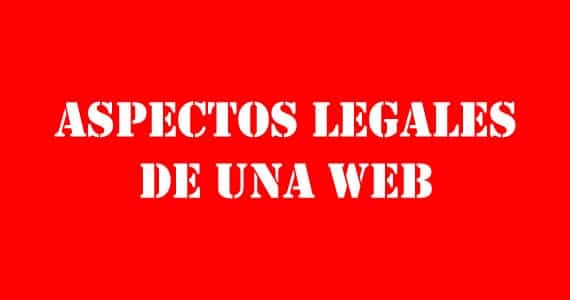
Do you know what is the Data Protection Act? Have you written the legal warning of your website? If the answer is no to any of the previous questions, you should know that you are breaking a law and, therefore, you can be sanctioned according to severity with the following sums of money: Very serious, from € 150.001 to € 600.000; serious, from € 30.001 to € 150.000 or mild, up to € 30.000.
Whether you are a web designer or if you have your own page, this post will interest you to read it. Find out well and ensure your site and that of your client knowing the legal aspects of a website.
Legal aspects
The legal notice
It corresponds to the text that collects the rights of the reader or visitor on a web page and the responsibility of the author or authors thereof. Any website that contains advertising of any kind (adsense, advertisers, affiliates ...) must have this document visible, even if it is a small blog. What this document will achieve is that, if some kind of problem occurs with a visitor, defend ourselves against the lawsuit. In addition, it will prevent us from incurring a penalty (and having to pay the consequent fine).
By now you will be crazy thinking about how to make a legal notice. And your intuition will lead you to googling, review a few websites, read their legal notices and copy a little from there and paste a little from there. ERROR! My great advice is that, whether the website is yours or if it is for a client, you go to a lawyer specialized in information technology. Recommend to your client to do so: although it may seem like a text with little visibility, usually located at the end of the page and in small print ... We cannot run the risk of creating a document that does not have any type of validity before a lawsuit.
And why do we have to include this information on our page? Because the Law 34/2002, of July 11, on services of the information society and electronic commerce.
The structure that a legal notice must follow
- General Information
- Intellectual property and use of content
- Data Protection
- Limitations or exclusions of liability
Terms of use
Generally, they are included within the legal notice (in the previous structure, it would correspond to the second part of point 2). As its name suggests, here we will have to refer to how a visitor can visit our website and in exchange for what.
The data protection law
If you collect any type of data from a user on your website, it is your obligation to comply with this law. As long as you have only a simple contact form on your page, in which the user must enter their email address ... Yes, friend, you also have to comply with this law. And it is not as easy to fulfill it as it may seem: you must create a file with all the data collected, which you must always keep updated, and register it with the AEPD, the Spanish Agency for Data Protection. We can carry out this action online with a prescription, an interactive PDF form provided by the agency itself: but you will have, at the end, to sign it electronically with a digital certificate. In a month, your file will appear on the web.
I said: if you want to comply correctly with the law, hire a professional who knows what he is writing and avoid copy-paste.